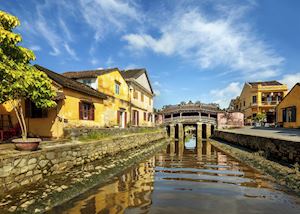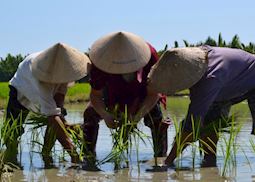Jump to:
In the 15th century, Hoi An became a lucrative stop for merchants, turning it into one of the busiest trading ports in Southeast Asia. This dominance was halted in the 18th century by a combination of rebelling dynasties and a silting river mouth. While terrible for business, these events protected the town from further development and it’s now a well-preserved patch of Vietnam’s history — albeit selling goods to visitors rather than merchants.
Hoi An’s architecture gives an insight into the town’s mixed heritage, with Dutch and French colonial houses squeezed between Chinese tea warehouses and Japanese temples. Local cafés, museums and open-fronted shops run alongside old canals.
Vietnam specialist AlexThere’s so much to do in Hoi An: wander through the Old Quarter, see the Merchant's Houses, enjoy the local market and its street food (try Lao Cau and White Rose Dumpling), get some tailoring done, visit the art quarter, visit the My Son ruins out of town — the list is endless.
Things to see and do in Hoi An
Order a tailor-made suit
Hoi An was once a major port on the Silk Route, high-quality fabric was easily available to the tailors of Hoi An, and at very low cost. The town has become well-known for its quality tailors, many of whom have been trading for generations.
More than 400 shops custom-make dresses, suits, shirts and leather shoes. You’ll even find on sale fancy dress outfits from the latest films. It’s best to allow a few days for your item to be made as your tailor will expect to carry out multiple fittings to get the garment size just right.
Explore the old town: a UNESCO World Heritage Site
 Many streets in Hoi An’s old town are car-free zones, making them ideal to explore on foot. Over 1,000 timber-frame buildings are still standing, topped with hand-carved tiles. The Chinese quarters are easy to spot for their wooden signboards gilded with Chinese characters — usually the name of the trading company. It’s possible to enter some of the meeting halls: there’s one for each Chinese province.
Many streets in Hoi An’s old town are car-free zones, making them ideal to explore on foot. Over 1,000 timber-frame buildings are still standing, topped with hand-carved tiles. The Chinese quarters are easy to spot for their wooden signboards gilded with Chinese characters — usually the name of the trading company. It’s possible to enter some of the meeting halls: there’s one for each Chinese province.
You enter the Japanese sector across a covered bridge: one of the few built outside Japan. Inside is a small temple to the Taoist god of weather, Tran Vo Bac De, an important figure to visiting sailors and merchants. There are a number of museums and homes open to visit, or you can simply enjoy ‘white roses’ (prawn dumplings) in one of the local cafés.
Go cycling in the surrounding countryside
The communities surrounding Hoi An profited from its importance as a trading town, selling a variety of local crafts to visiting merchants. These enterprises have bloomed into busy cottage industries, keeping Vietnamese handicraft skills alive. Cycling through the villages with an experienced guide, you can stop to visit the artisans along the way.
Along a leisurely 8 km (5 mile) route, you’ll ride past vivid green paddy fields and patches of farmland — usually tended by workers. Slow-flowing rivers weave across the landscape, often carrying small coracle boats — one of the most popular products made by hand here. Stopping to see traditional skills, such as wood carving and mat weaving, you’ll often be welcomed in by residents for a drink.
Visit the Cham ruins at My Son: a UNESCO World Heritage Site
The site of My Son lies in a geological basin surrounded by a ring of mountains, about an hour inland from Hoi An. The indigenous Cham tribes chose this easily defendable location to build the capital of their empire, which grew steadily between the 4th and 13th centuries. Used as a military base by the Viet Cong during the Vietnam War, My Son was heavily bombed, but many ruins remain standing.
When you arrive, it can take a moment to differentiate the temples’ towers from the surrounding rocks, which are all being gradually reclaimed by the jungle. Built from locally fired bricks, some temples have bent roofs, claimed by archaeologists to reflect the crooked peak of Cat’s Tooth Mountain in the distance. Walking around the site, it’s possible to spot some of the remaining sandstone bas-reliefs that would have once covered temples across the entire site.
Take a scenic drive up and over the Hai Van Pass
When driving around Hoi An, it’s worth taking a detour along the Hai Van Pass. Most traffic now bypasses the road through a 6.2 km (3.8 mile) tunnel, leaving the pass free for those who simply want to enjoy the views. The 19 km (12 mile) stretch of road climbs 3,000 ft (914 m) along the Annamite Range, which separates north and central Vietnam.
The road follows the Vietnamese coastline, with the South China Sea to the east and only jungle to the west. As you descend, the Lang Co Peninsula stretches right across the skyline. This beach-fringed headland is an ideal pit-stop, where you take a break at one of the few local bars selling juice and fruit.
Best time to visit Hoi An
February to May is usually a comfortable time to travel to Hoi An, when there’s plenty of sunshine, clear skies and warm temperatures. From June to August, skies remain clear but it can be quite hot with temperatures reaching 30°C (86°F). The rainy season runs from September through to January and floods can affect travel plans during this time.
Festivals, events and seasonal reasons to visit
- Hoi An celebrates the rise of the full moon each month. The city lights are turned off and streets are illuminated with rows of bright paper lanterns. Vehicles are banned and local people spend the evening watching cultural performances and attending candlelit temple ceremonies.
- Vietnamese New Year, known as Tet, usually falls in late January or early February. It’s celebrated across the country but festivities in Hoi An are particularly enthusiastic. Many visitors and Vietnamese wander the old town, which is lit with lanterns and lights floating on the canals. Country-wide, shops and restaurants tend to close for Tet, but some remain open in Hoi An, making it an ideal place to experience the festival.
who's been there
-
01993 838 92501993 838 140
- Make an enquiry
Suggested itineraries featuring Hoi An
Our itineraries will give you suggestions for what is possible when you travel in Hoi An, and they showcase routes we know work particularly well. Treat them as inspiration, because your trip will be created uniquely by one of our specialists.
Places near Hoi An
- Lang Co 31 miles away
- Bach Ma National Park 39 miles away
- Bho Hoong 39 miles away
- Hue 65 miles away
- Kon Tum 108 miles away
- Quy Nhon 158 miles away
- Phong Nha-Ke Bang National Park 187 miles away
- Buon Ma Thuot 222 miles away
- Central Highlands 223 miles away
- Nha Trang 258 miles away
- Dalat 272 miles away
Photos of Hoi An
Accommodation choices for Hoi An
We've selected a range of accommodation options for when you visit Hoi An. Our choices usually come recommended for their character, facilities and service or location. Our specialists always aim to suggest properties that match your preferences.
-
![Hoi An Chic Hotel, Hoi An]() Responsible ChoiceWe've hand-selected a range of tours and stays across the world that go above and beyond to be a force for good by supporting local businesses, educating staff, challenging local norms, or promoting conservation and biodiversity efforts. Your Responsible Choice helps increase the positive impact of your trip.
Responsible ChoiceWe've hand-selected a range of tours and stays across the world that go above and beyond to be a force for good by supporting local businesses, educating staff, challenging local norms, or promoting conservation and biodiversity efforts. Your Responsible Choice helps increase the positive impact of your trip.Hoi An Chic Hotel
Hoi An -
![pool area]()
Hotel Royal Hoi An
Hoi An -
![Pool at the Victoria Hoi An Beach Resort & Spa]()
-
![Pool Villa, Fusion Maia, Danang]()
Fusion Maia
Hoi An -
![Four Seasons Resort The Nam Hai, Hoi An]() Responsible ChoiceWe've hand-selected a range of tours and stays across the world that go above and beyond to be a force for good by supporting local businesses, educating staff, challenging local norms, or promoting conservation and biodiversity efforts. Your Responsible Choice helps increase the positive impact of your trip.
Responsible ChoiceWe've hand-selected a range of tours and stays across the world that go above and beyond to be a force for good by supporting local businesses, educating staff, challenging local norms, or promoting conservation and biodiversity efforts. Your Responsible Choice helps increase the positive impact of your trip.Four Seasons Resort The Nam Hai
Hoi An -
![La Siesta Resort & Spa, Hoi An]()
La Siesta Resort & Spa
Hoi An -
![Anantara Hoi An Resort , Hoi An]()
Anantara Hoi An Resort
Hoi An -
![Twilight Poolside]()
Boutique Hoi An Resort
Hoi An -
![Pool area, Little Riverside Hotel & Spa]()
Little Riverside Hotel & Spa
Hoi An
Ideas for experiencing Hoi An
Our specialists seek out authentic ways to get to know the places that could feature in your trip. These activities reflect some of the experiences they've most enjoyed while visiting Hoi An, and which use the best local guides.
-
Hoi An countryside cycling tour ![Local with bike, Hoi An]()
Hoi An countryside cycling tour
Hoi An countryside cycling tour
Pick up your bikes and begin a leisurely ride through the beautiful countryside with your guide, stopping for photographs and refreshments as you please.
View details -
The fishermen of Hoi An ![Fisherman, Hoi An]()
The fishermen of Hoi An
The fishermen of Hoi An
Explore a fishing village and learn about the fishermen and their daily lives.
View details -
My Son ruins ![My Son ruins, near Hoi An]()
My Son ruins
My Son ruins
My Son is Vietnam’s most important Cham site. The Cham civilisation dominated the area that is now south Vietnam for many centuries before being crushed by the Vietnamese.
View details -
Hands-on rice growing tour ![Planting the rice]()
Hands-on rice growing tour
Hands-on rice growing tour
You will be met at your hotel and transferred to the farm. On arrival you will meet the farmers and enjoy tea before donning traditional Vietnamese clothing (a conical hat and overalls) to prepare for getting into the paddy field.
View details -
Hoi An walking tour ![Japanese bridge, Hoi An]()
Hoi An walking tour
Hoi An walking tour
Hoi An's main sights of interest are all within the UNESCO-protected area adjacent to the river and your guide will escort you around the narrow winding streets on foot as cars are not allowed.
View details
































